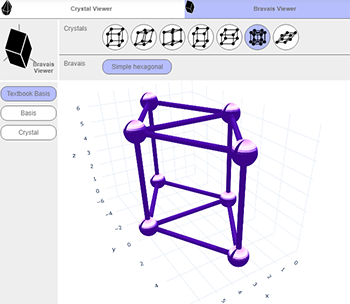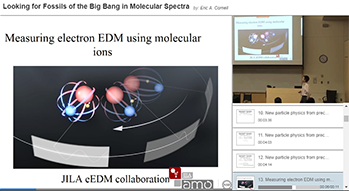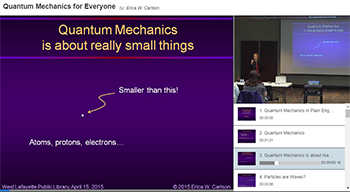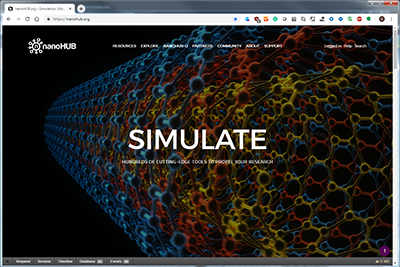|
Issue 37
A Totally New Look and Feel for Popular nanoHUB Tools
A message from Gerhard Klimeck, nanoHUB Director:
Thank you for being a nanoHUB user. I would like to share some exciting updates with you.
We are in the process of updating the nanoHUB simulation tools to receive a modern mobile-app look and feel that is interactive and user-friendly. As the new tools launch users will immediately see an interactive visualization of precomputed results. The controls to simulate new results have become more intuitive.
The first redesigned tools are as follows:
- The Crystal Viewer tool allows students to interactively visualize Bravais lattices, Miller planes, and crystal structures of specific materials needed for many courses in materials, electronics and chemistry. It has been used by over 70 classes in formalized instruction and has been utilized by over 12,000 users.
- With the P-N Junction Lab, users can explore and teach the basic concepts of P-N junction devices. They may edit the doping concentrations, change the materials, tweak minority carrier lifetimes, and modify the ambient temperature. Users can then see the effects in the energy band diagram, carrier densities, net charge distribution, I/V characteristic, and more. P-N Junction Lab has been utilized in over 150 classes for formalized instruction. Overall it has been used by over 13,600 users.
I invite you to try out Crystal Viewer, P-N Junction Lab, and any of the other 600+ tools on nanoHUB. We continue to modernize and improve tools every day, so watch this space for updates.
Kind regards,
Gerhard Support Nanotechnology Research with BOINC
You can contribute to progress in nanoscience and nanotechnology by running a free application.
Supporting nanoHUB@Home is now an option in the BOINC software, which lets you help cutting-edge research using your computer (Windows, Mac, Linux) or Android device. BOINC downloads scientific computing jobs to your system and runs them invisibly in the background. It's easy and safe. About 30 science projects use BOINC; examples include Einstein@Home, IBM World Community Grid, and SETI@home.
The nanoHUB@Home project supports over 200 simulation tools deployed at nanoHUB.org. These tools are used for both education and research, and they enable simulations that can run in a few minutes or over several hours.
Get started today at nanoHUB's BOINC website. Meet nanoHUB at ACS 2019
Are you planning to attend the ACS National Meeting and Expo in San Diego this year? Stop by nanoHUB's space in the exhibit hall at table #1345. Activities will demonstrate how our free online simulation tools can power STEM learning in your classroom. New on nanoHUB: Symposium on Quantum Technology
The Purdue Quantum Science and Engineering Institute, located in Discovery Park, hosted the International Symposium for Quantum Science and Technology on April 21-23. Composed of top researchers from around the globe, this symposium covered such topics as quantum matter, quantum photonics, quantum materials and devices, and quantum computation. The list of distinguished presenters included a Nobel laureate, as well as several scientists who came from countries overseas such as Austria, Denmark and Israel.
The talks were recorded and have been published on nanoHUB as a workshop series reviewing the current status and important recent international developments in quantum science and technology, and charting future directions for this hot-button topic. From nanoHUB Resources to "The Great Courses"
Have you watched Professor Erica W. Carlson's "Quantum Mechanics for Everyone" presentation on nanoHUB?
The producers of "The Great Courses" found her talk and invited her to create a series of 24 half-hour lectures based on the material, titled "Understanding the Quantum World".
In the series, Professor Erica W. Carlson of Purdue University guides learners through this fascinating subject, explaining the principles and paradoxes of quantum mechanics with exceptional rigor and clarity—and using minimal mathematics. The winner of multiple teaching awards, Professor Carlson is renowned for her “fantastic ability to develop and implement tools that help students learn a challenging subject”—in the words of one of her admiring colleagues. With her guidance, anyone can get a fundamental understanding of this wide-ranging field.
If you're interested in quantum mechanics, Professor Carlson's original lecture is still available on nanoHUB, and it's free! Share Your Feedback on the nanoHUB Website
nanoHUB is continuing efforts to improve the navigational ease of our landing and simulations pages. As part of this process, we would like to speak with less experienced nanoHUB users and watch them navigate nanoHUB.org. Can you spare a few moments to share your feedback? If so, please fill out the form at the following link.
nanoHUB UX Focus Group Sign Up
Your participation in the nanoHUB redesign process is greatly appreciated and will create a better experience for everyone.
Upcoming Events
ACS National Meeting and Expo
When:
August 25-29, 2019
Where: San Diego, CA
American Chemical Society National Meetings are where chemistry professionals meet to share ideas and advance scientific and technical knowledge. By attracting thousands of chemical professionals, the meeting provides excellent opportunities for sharing your passion for chemistry, connecting with the world’s largest scientific society, and advancing your career in this ever-changing global economy.
Website: ACS National Meeting and Expo 2019
Gateways 2019
When:
September 23-25, 2019
11:00 a.m. - 8:00 p.m. EDT
Where: San Diego, CA
The fourth Gateways annual conference (formerly the Gateway Computing Environments workshop series) is an opportunity for gateway creators and enthusiasts to learn, share, connect, and shape the future of gateways as part of a vibrant community with common interests. This gathering for gateway creators and enthusiasts features hands-on tutorials, demos, keynotes, presentations, panels, posters, and plenty of opportunities to connect with colleagues.
Website: https://sciencegateways.org/web/gateways2019/welcome

New Resources
With the continually increasing food and energy demands which require sustainability, novel solutions in which agrivoltaic is a part of are pushed to solve local land shortages and increase land productivity. Compared to traditional solar energy installations which casts deep shadows on the ground and prevent crops from growing, agrivoltaic can develop strategies on design optics that allows simultaneous coproduction of food and energy. The Agrivoltaic Simulation tool will calculate based on the solar panel parameters, geometries, patterns, and tracking system to provide outputs of contour shadowmaps, solar and electrical power output plots, along with input-output tables.
This tool calculates the surface area of nano-porous materials such as metal organic frameworks (MOFs) and zeolites. Materials used in this tool include: IRMOF-1, IRMOF-2, IRMOF-3, IRMOF-10, IRMOF-12, IRMOF-16, ITQ-1, ITQ-3, ITQ-7, ITQ-12, ITQ-29, KFI, LTA4A and LTA5A.
Scaling up the manufacturing of atomically thin layers (2D materials) demands high-throughput non-destructive characterization techniques to quickly provide insights into the materials’ quality and yield. 2dreflect is an analysis software tool developed to characterize experimental samples of 2D materials, including monolayer, homogenous multilayer and heterostructure, based on the simulation of their theoretical optical contrasts under certain illumination wavelengths.
A discussion of research into new ways for the realization of plasmonic and nanophotonic devices - from material building blocks to advanced designs and demonstrations. Professor Alexandra Boltasseva aims to develop new technological platforms to unlock properties of nanophotonic structures in previously unavailable designs and wavelength regimes and to enable new generations of low-loss, tunable, reconfigurable, semiconductor-compatible devices for applications in onchip optics and optoelectronics, information processing, data recording/storage, nanoscale light manipulation, sensing, medical imaging and therapy, and energy conversion.
This presentation discusses the Center for Quantum Information and Computation for Chemistry, and will investigate information techniques used to gain novel viewpoints on diverse chemical processes from photosynthesis to bond breaking.
|








